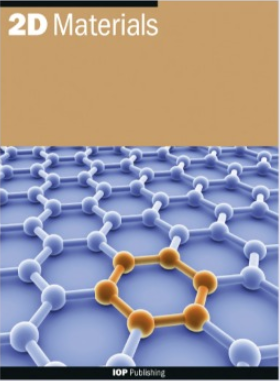来自Förster在任意扭曲的单层半导体堆叠中耦合的跨维谷激子
IF 4.3
3区 材料科学
Q2 MATERIALS SCIENCE, MULTIDISCIPLINARY
引用次数: 1
摘要
摘要:在具有任意扭转角的过渡金属二硫族化物单层堆中,我们探索了一类由明显的Förster耦合产生的新的亮激子,其维数由其面内动量调节。小动量下的低能扇区是二维的,具有墨西哥帽色散,而大动量下的高能扇区则是三维的,面内和面外的群速度都相当大。通过选择间隔层厚度,可以从拓扑原点的跨维体色散中产生定位于指定层的多种表面或界面激子模式,并将其映射到Su-Schrieffer-Heeger孤子上。此外,间隔层中的阶跃边缘可以用于工程横向界面,以实现拓扑界面激子的层间通信。结合从单层构建块继承的极化选择规则,这些奇异的激子特性为面向谷激子光电子三维集成的多层设计开辟了新的机会。本文章由计算机程序翻译,如有差异,请以英文原文为准。
Cross-dimensional valley excitons from Förster coupling in arbitrarily twisted stacks of monolayer semiconductors
Abstract In stacks of transition metal dichalcogenide monolayers with arbitrary twisting angles, we explore a new class of bright excitons arising from the pronounced Förster coupling, whose dimensionality is tuned by its in-plane momentum. The low energy sector at small momenta is two-dimensional, featuring a Mexican Hat dispersion, while the high energy sector at larger momenta becomes three-dimensional (3D) with sizable group velocity both in-plane and out-of-plane. By choices of the spacer thickness, versatile surface or interface exciton modes localized at designated layers can emerge out of the cross-dimensional bulk dispersion for a topological origin, which can be mapped to the Su–Schrieffer–Heeger soliton. Moreover, step-edges in spacers can be exploited for engineering lateral interfaces to enable interlayer communication of the topological interface exciton. Combined with the polarization selection rule inherited from the monolayer building block, these exotic exciton properties open up new opportunities for multilayer design towards 3D integration of valley exciton optoelectronics.
求助全文
通过发布文献求助,成功后即可免费获取论文全文。
去求助
来源期刊

2D Materials
MATERIALS SCIENCE, MULTIDISCIPLINARY-
CiteScore
10.70
自引率
5.50%
发文量
138
审稿时长
1.5 months
期刊介绍:
2D Materials is a multidisciplinary, electronic-only journal devoted to publishing fundamental and applied research of the highest quality and impact covering all aspects of graphene and related two-dimensional materials.
 求助内容:
求助内容: 应助结果提醒方式:
应助结果提醒方式:


